
The Embedded web server is a combination of embedded devices like micro-controller, micro-processor etc along with internet technology. The main purpose of using embedded devices is that they can be accessed, monitored and controlled through remote devices by using the internet [3]. This paper presents a design of embedded web server by using ARM920T processor. The server is implemented in Visual Basic (VB) with Active Server Page (ASP) [5]. After the successful development of the server, it is transplanted on the ARM processor. Windows Embedded Compact (WIN CE) is the operating system used in the ARM processor which is specially designed for embedded systems [1]. The existing method in web server design involves Java program, which is successful only if the requirements are satisfied [2]. The main hurdles on using Java servlet are Java plug-in content needs to be installed both client and server, the web server is not dynamic and hence it merely exchanges data with the client, the configuration of Java program is complex and it is difficult to modify it [2]. This paper gives an outlook about overcoming these drawbacks of Java applet by using embedded web server. AVR ATmega324 is a micro-controller which is used to control the wireless communication between the ARM processor and the client [4].
Introduction
An embedded system is a device that has computer intelligence and is dedicated to performing a single task, or a group of related tasks [3]. Embedded systems often perform monitoring and control functions such as gathering and reporting sensor readings or controlling motors and switches [3]. A web server is a system which hosts websites and provides services for any requesting clients. The general purpose web server composes of an operating system, web pages or web applications and a huge amount of memory and sometimes a special hardware. Fig.1 represents the simple diagram of the embedded web server.
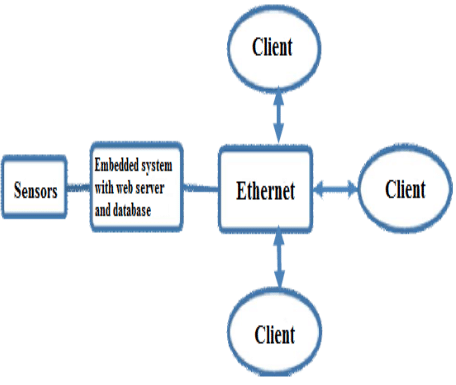
The embedded web server is the combination of embedded device and Internet technology, which provides a flexible remote device monitoring and management function based on Internet browser and it has become an advanced development trend of embedded technology [3].
Existing System
In the existing systems PC is the central Part of remote monitoring system. The design can shorten the development cycle with the help of mature development tools on the PC platform. The promise of web services is to enable a distributed environment in which any number of applications, or application components, can interoperate seamlessly among and between organizations in a platform-neutral, language-neutral fashion. This interoperation brings heterogeneity to the world of distributed computing once and for all. Fig.2 shows the existing system.
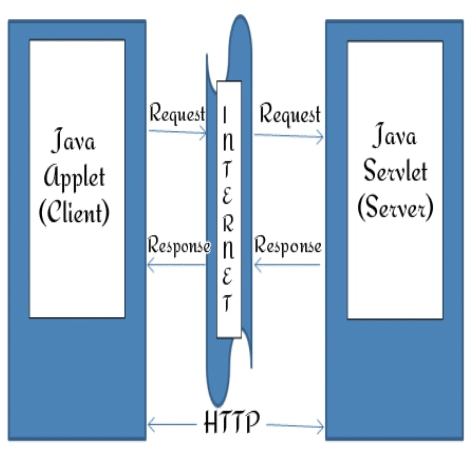
The process of web service involves two computers in which one acts as the browser and the other acts as the server to the client. The client first sends request based on the information he needs through Java Servlet [2]. Java servlet is a special protocol which converts machine language to Java program language. The request is sent to the web server through internet. The web server is also a personal computer which contains Java servlet for decryption of request and transferring back the response to the client [2].
JAVA Servlet Hurdles
Java is the one of the most commonly used programming languages for developing enterprise and e-commerce applications. Java programming language offered a platform neutral alternative such that developers could program object-oriented applications in a platform-independent manner. Although programming languages like C and C++ were flexible enough to develop a variety of complex applications, they lacked in resolving the core architecture of integrating the programming requirements of the internet. The Java servlet attempts to meet these needs at the infrastructure level [2]. By using java servlet it is easy to monitor the server independently and request and response for multiple clients are possible. It also provides proper load balance between the client and the web server [2]. Though it has many advantages when compared with other web server programming protocols, it also suffers few conflicts which are mentioned below:
- The maintenance burden on the server would be heavy because java servlet must be installed at every remote terminal [2].
- It merely exchanges data from the web server to the client and it does not provide any additional information based on client request [2].
- Java servlet requires java plug-in which is complex to configure. Hence it is difficult to modify the contents of java servlet [2].
Proposed Method
This paper presents the design of an embedded web server system by which it is possible to control and monitor of remote device. Server is implemented on this processor. Advanced RISC Machine (ARM) 32 bits processor has power full rich instruction sets, 16KB instruction cache, 16KB data cache, Full Memory Management Unit, Write Buffer [1]. The friendly ARM also known as mini S3C2440 processor is a complete minicomputer. It supports Linux and Win CE operating system .The proposed design is based on the Win CE.net 5.0operating system. Server is implemented in ASP that overcomes the problems faced by using the java servlet [5]. After the successful realization of server on mini2440 board this server system can be used to monitor and control of remote device. Sensor expansion board is used to send wireless signal from sever to the device. For wireless communication RF module is attached with each device which continuously send data about the device to the server via sensor expansion board. Sensor expansion board based on AVR ATmega324, because it has two UART, one UART port is connected to the ARM processor and second port is connected to the RF module [1]. Frequency of RF module is 433 MG Hz. LM35 sensor is used in each RF module [4]. It sense temperature of environment .The temperature is used for threshold value. Based on this threshold value the device will be switched on or off. Each RF module controlled by AVR AT mega 8 microcontrollers [4].
System Component
The design in this paper applies MINI2440 32-bit ARM microprocessor which takes ARM920T as its core. The MINI2440 Development Board is based on the Samsung S3C2440 microprocessor [1]. Its PCB is 4-layer boarded, equipped with professional equal length wiring which ensures signal integrity. The MINI2440 development board equipped with a wide variety of connectors, interfaces and ports [1]. Fig. 3 shows the general ports of Samsung S3C2400.
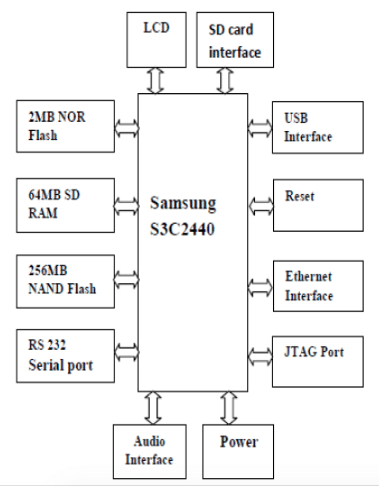
Key Technology Used For The Implementation
The frequency Samsung S3C2440AL is 400MHz and can up to 533MHz in the maximum [1]. According to its mode of internal circuit. 12MHz chosen for the crystal. JTAG (Joint Test Action Group) is an international test protocol standard, software simulation, single-step debug and u-boot download can be carried out through the JTAG port, it’s a simple and efficient means of developing and debugging embedded systems. The SDRAM capacity in the system is 64MB, working voltage is 3.3V, data bus is 32bit, clock frequency up to 533 MHz Auto-Refresh and Self-Refresh are both supported [1]. For supporting boot loader in the NAND Flash,, a buffer named Steppingstone is equipped in SDRAM. When the system starting, the first 4Kbyte content in NAND Flash is load to the Steppingstone and is executed. When Start-up code, the contents of the NAND Flash are copied to the SDRAM in general. The data is in NAND Flash are checked when ECC is used. The main program will be executed on the SDRAM based on the completion of copy. S3C2440AL UART provides three serial I/O port, each port can operation on interrupt or DMA mode [1]. UART can support a maximum baud rate of 115.2Kbps when using the system clock. Each UART channel for the receiver and transmitter includes two 64-bit FIFO. Web server is implemented on this platform. In the proposed work the web server is used to control and monitor of remote device. To achieve remote communication to the devices a sensor expansion board is connected with the mini2440 board via COM1 port, at baud rate of 2400 using RS232 serial communication standard [1]. In sensor expansion board AVR ATmega324 microcontroller is used to achieve wireless communication via RF module [4]. The AVR is a Modified Harvard architecture 8-bit RISC single chip microcontroller (μC) which was developed by Atmel in 1996.AVR ATmega 324 is an 8bit (μC), with two UART port. In the proposed design both ports are used, one port is connected to the mini2440 board to communication with web server, another port is connected to the RF module [4]. Frequency of RF module is 433MHz.Sensor expansion acts as controller for remote device. At each device relay is used to switch on or off the device [3]. Each Device is controlled via ATmega 8 micro controller. At PORT D of AVR ATmega 8 (μC) the RF module is attached, and at PORT B the device is connected via relay [3].
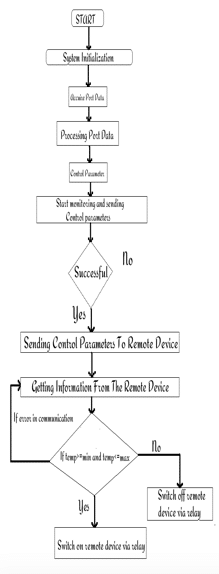
Fig.4 shows the flow chart for establishing the dynamic webpage and activating the remote devices by assigning the control parameters in ASP.NET. The monitoring program for the sensor expansion board and the monitoring program at mini2440 board make up the components of the system’s software. The control center, ARM920T processor, uses Win CE as the operating system. Thus, its kernel can be reduced and it takes small part of the system memory. The development languages for the system program are ASP (Active Server Page), VB (Visual Basic) and during the development process, development environment, Microsoft visual studio-2008 used. The monitoring program includes information collection, processing, sending and receiving program, and information display program. It has the following two main functions:
i) Communicating with sensors expansion board, including real-time data of environment and reading, controlling parameters etc.
ii) Storing, processing and displaying data, communicating with remote device through sensor expansion board
In the information collection program, firstly, it opens the serial device, goes through the initialization of simple serial port and sets baud rate and other information, which will enable serial communication between the server based on S3C2440 and the sensor expansion board. Then by reading the serial data, data collected by the sensors is going to be stored into S3C2440 and the server is going to process this information and send it to a remote devices by the information processing and delivery programs.
The information display program is responsible for displaying control parameters, which is developed by using cross- platform GUI. Information display program is separated from others as it continues to read parameters like temperature from the remote device and keeps updating the temperature. If the received temperature is greater than or equal to the minimum threshold value and less than or equal to the maximum threshold value than the device will be switched on, otherwise the device will be switched off .Each device is attached with RF module that continuously send information to the sensor expansion board.
System Architecture
System architecture of An Embedded Web Server System which controls and monitors the remote devices is presented. The system uses 32-bit RISC processor Samsung S3C2440 with various features and peripherals. It’s based on ARM 920T core and supports embedded Linux, WinCE, VxWorks and other embedded operating system. In the System architecture of An Embedded Web Server System which controls and monitors the remote devices is presented. The system uses 32-bit RISC processor Samsung S3C2440 with various features and peripherals [1]. It’s based on ARM 920T core and supports embedded Linux, WinCE, VxWorks and other embedded operating system [1]. In this paper Win CE Operating system is transplanted on S3C2440 processor. The hardware of the system is designed in four parts:-
- The first part that is the core of the architecture based on ARM 920T processor. The Win CE.net5.0 operating system is transplanted on the ARM based mini2440 board. The user interface is developed in ASP (Active server page) technology. After that Web server is transplanted to the S3C2440 ARM processor.
- The second part of the system architecture is the sensor expansion board which based on AVR ATmega324 microcontroller. It has a special feature of power on reset. It is connected with embedded web server system via RS232 serial interface and sends the information regarding the remote devices to the web server.
- The third part of the system architecture is the wireless communication module. In this module remote devices are connected to the sensor expansion board via RF module. RF transceiver is different from general wireless transceiver for broadcasting in the respects of small size, low power consumption, support for battery-powered devices. RF transceiver is mainly responsible for modulation, demodulation, sending and receiving of signal. It is mainly used in RF signal processing, control, coordinating all parts of the device and communicating with external devices through the serial port.
- In the fourth part the embedded web server system will be connected to the LAN/ or internet via Ethernet interface. On the client PC remote user can access the information of the remote devices through the web pages which will be transmitted by the web server .System is based on Browser/server architecture.
Fig.5 Shows the system architecture which is used for creating the embedded web server using ARM processor.
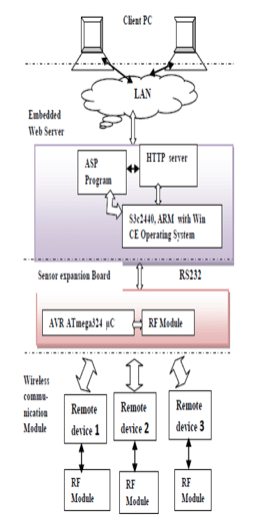
Relay Circuit
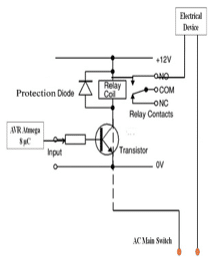
Fig.6 shows the relay circuit used to switch on and switch off the electrical device using npn transistor. The sensor expansion board acts as mediator between the remote device and server. It receives the entire request from the server and based on this request forward it to the RF module which is attached with the remote device. Based on the received request relay is tripped, and the device will be turned on or off. The wireless sensor node is controlled by AVR ATmega8 microcontroller [4]. It is a 28 pin IC. At port D RF module (RF Transreceiver) is connected and at port B relay is connected .Across relay electrical device is connected. The figure shows the inner structure of relay [3]. When the noted temperature is greater than the maximum threshold temperature, the relay acts as short circuit, and completes path between the device and main switch [3]. Device will be switched on. If the noted temperature is below the minimum threshold temperature then the transistor will be reverse biased, and acts as open circuit [3]. Hence the device across the relay will be switched off [3].
Conclusion
In this paper an Embedded Web Server system design is present through which remote devices can be controlled and monitored. The paper presents system by which it is possible to controlling and monitoring any electrical device. In various Internet applications based on client server architecture, it is better to use embedded web server other than PC server which decreases volume, cost and power consumption. Remote monitoring system based on embedded web server. The design will overcome the drawbacks of Java Servlet [2]. In place of Java Servlet, Visual Basic is used for development of user interface [5]. User can control, monitor, and diagnose the problem with the remote devices. The design is based on ARM-Win CE operating system [1]. Instead of using computers for creating a web server we can use simple embedded system using ARM processor which would greatly reduce the cost and reduce the complexity. The developed system is applicable in Industries, Research, and Educational Institution etc. The whole system has low-cost, good openness and portability, and is easy to maintain and upgrade. By implementing this embedded system the personal computers can be replaced since the total cost of creating this embedded web server would reduced by 50 percent. Hence by using the embedded web server technology, energy, time and human workload can be greatly reduced.
References
- ARM Microprocessor Basics, “INTRODUCTION TO ARM PROCESSOR”, Embeddedcraft.
- Subrahmanyam Allamaraju, “JAVA SERVER PROGRAMMING”.
- Scott R. Little, “Embedded System Design”.
- Dhananjay V. Gadre, “PROGRAMMING AND CUSTOMIZING THE AVR MICROCONTROLLER”.
- Andrew J. Bennieston, “VISUAL BASICS FOR ASP.NET”.









Where is the author name
Hi Pankaj Raut, we have updated the article with correct author name, please check.